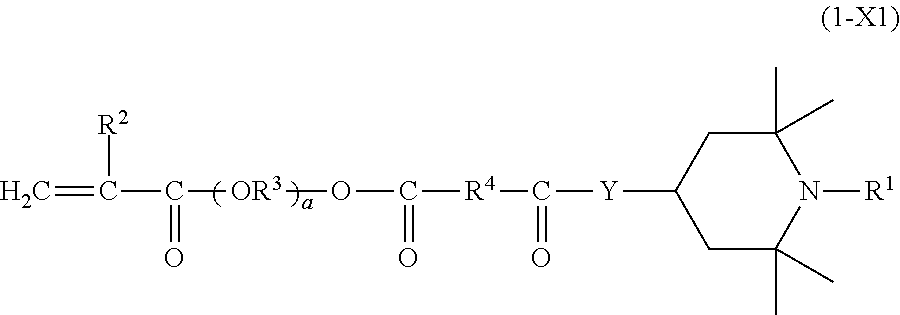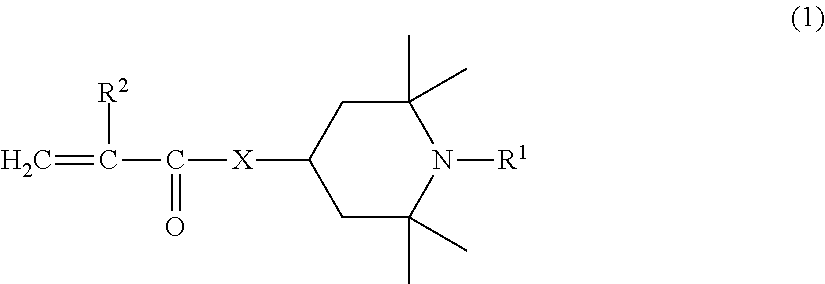(METH)acrylate compound and photochromic curable composition containing the (METH)acrylate compound
a technology of acrylate compound and acrylate compound, which is applied in the field of (meth)acrylate compound and novel curable composition, can solve the problems of lens surface or coating turbidity, lens color loss, lens material or coating yellowing, etc., and achieve excellent photochromic properties, improved durability, and free from bleeding
- Summary
- Abstract
- Description
- Claims
- Application Information
AI Technical Summary
Benefits of technology
Problems solved by technology
Method used
Image
Examples
synthesis example 1
Synthesis of a 2-acryloyloxyethylsuccinic acid (1,2,2,6,6-pentamethyl-4-piperidyl)ester (abbreviated as HM-01)
[0472]In a 500-ml four neck distillation flask, there were set stirrer vanes, a thermometer and a dropping funnel, and there were fed:[0473]2-acryloyloxyethylsuccinic acid, 10.8 g (0.05 mols),[0474]1,2,2,6,6-pentamethyl-4-hydroxypiperidine, 17.0 g (0.1 mol),[0475]4-(N,N-dimethylamino)pyridine, 6.1 g (0.05 mols), and dehydrated tetrahydrofurane, 200 mL.
[0476]The mixture was cooled to 0° C. and to which 12.1 g (0.012 mols) of a dicyclohexylcarbodiimide was added little by little. The mixture was stirred at 0 to 5° C. for 10 minutes and was, further, stirred at room temperature overnight. The white solid matter that has precipitated was separated by filtration. To the filtrate was added 400 mL of toluene followed by washing with water three times each time with 400 mL of water. Further, the organic layer was washed two times each with 200 mL of 0.5N hydrochloric acid solution. ...
synthesis example 2
Synthesis of an acryloyloxypolycaprolactone (c≈2) carboxylic acid (1,2,2,6,6-pentamethyl-4-piperidyl)ester (abbreviated as HM-02)
[0481]In the 500-ml four neck distillation flask, there were set the stirrer vanes, the thermometer and the dropping funnel, and there were fed:[0482]acryloyloxypolycaprolactone (c≈2) carboxylic acid, 15.0 g (0.05 mols),[0483]1,2,2,6,6-pentamethyl-4-hydroxypiperidine, 17.0 g (0.1 mol),[0484]4-(N,N-dimethylamino)pyridine, 6.1 g (0.05 mols), and[0485]dehydrated tetrahydrofurane, 200 mL.
[0486]The mixture was cooled to 0° C. and to which 12.1 g (0.012 mols) of the dicyclohexylcarbodiimide was added little by little. The mixture was stirred at 0 to 5° C. for 10 minutes and was, further, stirred at room temperature overnight. The white solid matter that has precipitated was separated by filtration. To the filtrate was added 400 mL of toluene followed by washing with water three times each time with 400 mL of water. Further, the organic layer was washed two times...
synthesis example 3
Synthesis of a 2-acryloyloxyethylsuccinic acid (1,2,2,6,6-pentamethyl-4-piperidyl)amide (abbreviated as HM-03)
[0491]In the 500-ml four neck distillation flask, there were set the stirrer vanes, the thermometer and the dropping funnel, and there were fed:[0492]2-acryloyloxyethylsuccinic acid, 10.8 g (0.05 mols),[0493]1,2,2,6,6-pentamethyl-4-aminopiperidine, 17.0 g (0.1 mol),[0494]4-(N,N-dimethylamino)pyridine, 6.1 g (0.05 mols), and dehydrated tetrahydrofurane, 200 mL.
[0495]The mixture was cooled to 0° C. and to which 12.1 g (0.012 mols) of the dicyclohexylcarbodiimide was added little by little. The mixture was stirred at 0 to 5° C. for 10 minutes and was, further, stirred at room temperature overnight. The white solid matter that has precipitated was separated by filtration. To the filtrate was added 400 mL of toluene followed by washing with water three times each time with 400 mL of water. Further, the organic layer was washed two times each with 200 mL of 0.5N hydrochloric acid ...
PUM
| Property | Measurement | Unit |
|---|---|---|
| photochromic | aaaaa | aaaaa |
| photochromic property | aaaaa | aaaaa |
| Photochromic | aaaaa | aaaaa |
Abstract
Description
Claims
Application Information
 Login to View More
Login to View More - R&D
- Intellectual Property
- Life Sciences
- Materials
- Tech Scout
- Unparalleled Data Quality
- Higher Quality Content
- 60% Fewer Hallucinations
Browse by: Latest US Patents, China's latest patents, Technical Efficacy Thesaurus, Application Domain, Technology Topic, Popular Technical Reports.
© 2025 PatSnap. All rights reserved.Legal|Privacy policy|Modern Slavery Act Transparency Statement|Sitemap|About US| Contact US: help@patsnap.com



